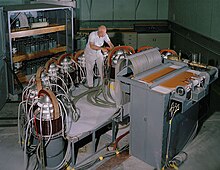
Theta-pinch, or θ-pinch, is a type of fusion power reactor design. The name refers to the configuration of currents used to confine the plasma fuel in the reactor, arranged to run around a cylinder in the direction normally denoted as theta in polar coordinate diagrams. The name was chosen to differentiate it from machines based on the pinch effect that arranged their currents running down the centre of the cylinder; these became known as z-pinch machines, referring to the Z-axis in cartesian coordinates.
Theta-pinch was developed primarily in the United States, mostly at the Los Alamos National Laboratory (LANL) in a series of machines known as Scylla. In 1958, Scylla I was the first machine to clearly demonstrate thermonuclear fusion reactions of deuterium in a controlled manner. It became one of the major lines of fusion research during the 1960s. General Electric and the Naval Research Laboratory also experimented with the concept, and later, many international labs. A series of machines was capped by the Scylla IV which demonstrated temperatures as high as 80 million K, more than enough to sustain a burning plasma. During these runs, Scylla IV produced billions of fusion reactions.
The Scylla machines also demonstrated very poor confinement times, on the order of a few microseconds. It was believed this was due to losses at the ends of the linear tubes. Scyllac (Scylla-closed) was designed to test a toroidal version that would improve confinement a thousandfold. A design mistake led to Scyllac being unable to come anywhere near its desired performance, and the United States Atomic Energy Commission shut the program down in 1977 to focus on the tokamak and magnetic mirror.
Some of the lack of interest in theta since the 1970s is due to a variation of the design known as the field-reversed configuration, or FRC, which has seen significant exploration. In this version, the induced magnetic fields are coaxed to take on a closed form that gives better confinement. The differences are enough that FRCs are considered to be a separate concept. Likewise, theta-pinch is often seen in magnetized target fusion systems, but these also differ significantly from the original concept.